
- The participatory, egalitarian, sustainable and Basque festivities are the ones that drive the most powerful movements in favor of the popular festivities. We've approached them to tell us the challenges they have in their hands. The wave of this holiday model is unstoppable in Euskal Herria, and we have also wanted to know which neighborhoods and villages they bathe.
The feast appears linked to the rite in the history of the human being and has as its core the expression of collective joy. This is explained by the sociologist Markel Ormazabal. “The joys expressed collectively represent a lot more of the group than any idea, symbol or discourse. However, today, this joy that we express in an organized manner is often depicted as a simple sum of personal joy, a reflection of extreme individualism. Not for nothing, social conflicts are also repeated at parties, insofar as parties are an unspeakable part of society. Moreover, the festivities show the trends and limitations that are still deeply rooted in society.”
Thus, Ormazabal has affirmed that the party is a totally political concept, since the community is a means of achieving something based on politics and “parties can strengthen society, the community. The organization of civil society is the road to the construction of collective life and social transformation, and parties are conducive to this, for the opportunity they offer for flexibility, self-organization and transgression”.
In this sense, beyond the festivities that are limited to consumption, hedonism and purely playful, there is a need for popular festivities that promote liberating values. In Ormazabal’s words, “the logic of popular construction, today more than ever, is in opposition to the dominant logic in our model of society. Therefore, in addition to keeping the neighborhoods and towns alive, the initiatives born of the popular movement must be used to transform current trends and values: to be collective activities elaborated from the critical, creative, anticapitalist, non-patriarchal, self-critical, environmental, in favor of other consumption models, multicultural”. In this direction, the following groups go very well.
Top Pamplona: gender and sexist aggressions as object of study
About 12 years ago the txosnas disappeared in Pamplona, “immediately after Barcina entered the mayor’s office,” says Xabier García Gora, a member of the Iruñea platform. Gora Iruñea met in 2006 to address the obstacles that UPN had continuously placed on Navarre society. Composed of the festival commissions of the neighborhoods, they manage several festivities throughout the year and there is a permanent group to carry them out, as well as a working group dedicated to organizing the Sanfermines and the Day of Pamplona. The platform has prepared the space for the Sanfermines this year.
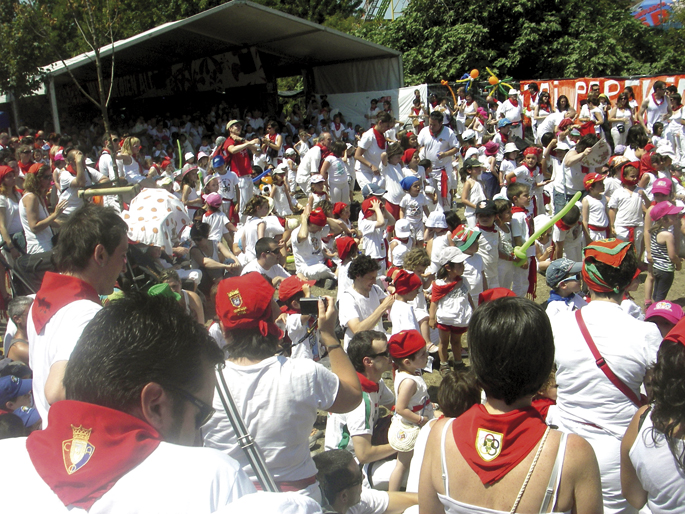
With the values of the popular festivities assumed, special work is being done on equality. “Unfortunately, in addition, we have recently suffered sexist assaults in the festivities of the neighborhoods of Txantrea and Iturrama,” García said. On the one hand, they have defined and established criteria for the meaning of egalitarian holidays, taking care of parity both in the holiday program and in the internal organization, in the number of men and women who prepare them. On the other hand, they have addressed the issue of sexist aggressions in the Basque Autonomous Community. They have promoted prevention and awareness, “making known through different media what healthy ligoteing is and what aggression is”, and have organized feminist self-defense workshops to explain how to act in the face of sexist aggressions. The protocol, contained in a report of twenty pages, is also ready for society to decide what action it can take in the face of the attacks and what steps the platform will take to denounce and combat it. The idea is to extend to the neighborhoods the protocol that is being distributed and disseminated. “The images that were taken last year in the sucking and that spread to the world have seemed shameful to us and have not even been denounced by the institutions,” García said.
The platform’s desire is for the sanfermines to be organized jointly, and to do so, the City Hall has organized a table in which the City Hall and the citizens will participate. “In the 1990s, the councilors, the peñas and the agents of the popular movements met to decide the program. At present, however, the City Hall calls out most of the public places for private companies to take over the holiday program. That’s not the way.”
EHZ, sustainability model
This year the Euskal Herria Zuzenean festival in Lekorne celebrated its nineteenth edition. It was born with the objective of dynamizing the interior and uniting people around music, around values such as the anti-capitalist, the left-wing, the feminist… “and above all, what makes us very different: to be a festival without a logo, without any brand of clothing or drink. When a company or private brand finances the festival it aims to advertise and when it loses interest it cuts funding. Our project is done by the citizens, and to the extent that the citizens take the festival and use it to respond to their needs, our survival will not be subject to private interests, but to the service of collective interests”, said the president of the association, Eneko Etxegarai.
For three 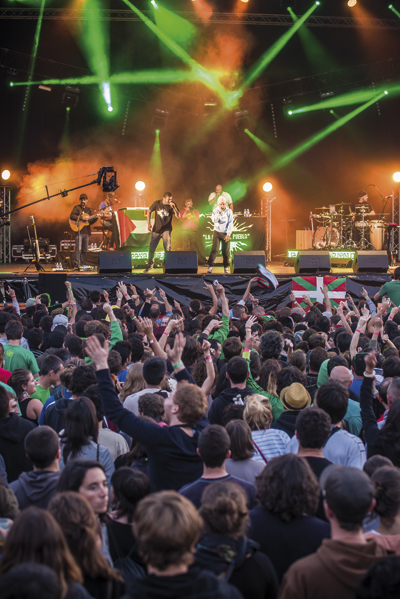 or four years, EHZ has made a great effort to reinforce another value: sustainability. More than 20 dry toilets have been built, for example, and recycling and waste management are perfectly organised. “After a festival that brings together 12,000 people, the goal is to leave the land and the environment as they used to, minimize the possible impact.” What has been done to achieve this is being taken up in a report “for our experience to be nurtured for other popular movements and initiatives”. In addition, the festival distributes food from local producers, of good quality and suitable to the money bags of the entire population. “Feeding so many people with the products of local producers is an incredible task and at first it was difficult to do it networking, but we have achieved it and it is very positive, a unique opportunity to make the economy of the environment live.” In addition, this year, in collaboration with other groups in favor of popular festivities, two mobile txosnas have been built that can be carried from one event to another in the Basque Country. The plans have been made by a carpenter of the festival, who has carried out everything in auzolan.
or four years, EHZ has made a great effort to reinforce another value: sustainability. More than 20 dry toilets have been built, for example, and recycling and waste management are perfectly organised. “After a festival that brings together 12,000 people, the goal is to leave the land and the environment as they used to, minimize the possible impact.” What has been done to achieve this is being taken up in a report “for our experience to be nurtured for other popular movements and initiatives”. In addition, the festival distributes food from local producers, of good quality and suitable to the money bags of the entire population. “Feeding so many people with the products of local producers is an incredible task and at first it was difficult to do it networking, but we have achieved it and it is very positive, a unique opportunity to make the economy of the environment live.” In addition, this year, in collaboration with other groups in favor of popular festivities, two mobile txosnas have been built that can be carried from one event to another in the Basque Country. The plans have been made by a carpenter of the festival, who has carried out everything in auzolan.
The Board of Directors, the satellite working groups, the committees, the collaborators… and the general assembly that brings together all of them take forward the LER. They also organise other activities throughout the year: “Around values, we put in place the means to push forward the initiatives that people propose. After all, what we imagine, live and put into practice for three days is the model of the Basque Country and society we want for tomorrow,” says Etxegarai.
Bilboko Konpartsak promotes social economy
The comparsas of Bilbao maintain the spirit that was launched in 1978 as the basis for popular festivities and citizen participation. The diversity of people and the coexistence around this diversity is one of the strengths of the comparisons, according to spokeswoman Itziar Villafañez. Each comparison has its own form of organization and disseminates its demands, concerns and messages in banners and acts (Euskalzale, feminism, environment…) from very different areas.
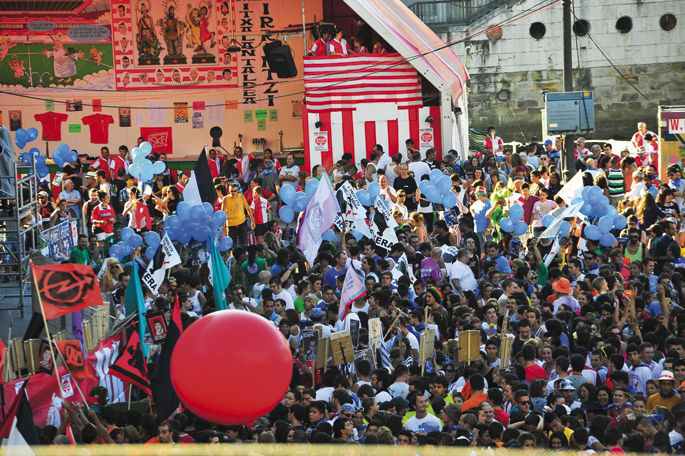
“We are a strong popular movement in Bilbao, we have many interesting proposals and we always have many open fronts. Either on the subject of reusable vessels, in the care of people in situations of social exclusion or dependency (on the proposal of the Etorkintza Foundation), or in measures to cope with aggression. Sexist, xenophobic or racist attacks, because parties are for everyone. We have started to develop the integration of all in a positive way; there has also been an association of immigrants with the intention of creating a comparison, which will surely make it easier for that line to arrive more seriously”, explained Villafañez.
This year’s wager is to use the currency of Bizkaia, Ekhi, for the benefit of the region’s economy. “We are strengthening ties with the organizations that drive the social economy and with local producers. To make the chocolates that we distribute at the Feast of San Juan, for example, we have used fair trade chocolate and milk from the Esnetik Cooperative.” Esnetik is a non-profit mixed cooperative for the production and consumption of dairy products by the baserritars of Aiaraldea and Durangaldea.
Donostiako Piratak: Giant Auzolan
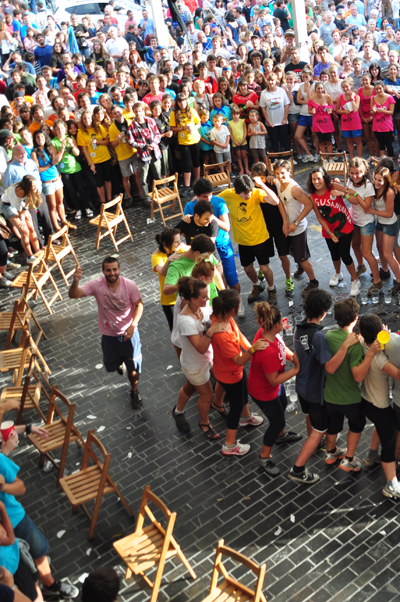 Since the San Sebastian approach was decided in 2003, pirates have recreated the festive model of the city. They share values such as the Zero Zabor philosophy, self-management, parity, vasquity… and the critical spirit (Irrikitaldia, as you can see in popular parodia). According to Aitor Alberdi, coordinator of Pirates, the auzolan is his greatest treasure: “Our festivities are a reflection of a gigantic auzolan. Each helps as much as possible, voluntarily, to get the Aste Nagusia forward, and is also a tool that goes beyond parties. For example, when we suffered the floods in Martutene, we went to clean the auzolan neighborhood along with other popular movements.”
Since the San Sebastian approach was decided in 2003, pirates have recreated the festive model of the city. They share values such as the Zero Zabor philosophy, self-management, parity, vasquity… and the critical spirit (Irrikitaldia, as you can see in popular parodia). According to Aitor Alberdi, coordinator of Pirates, the auzolan is his greatest treasure: “Our festivities are a reflection of a gigantic auzolan. Each helps as much as possible, voluntarily, to get the Aste Nagusia forward, and is also a tool that goes beyond parties. For example, when we suffered the floods in Martutene, we went to clean the auzolan neighborhood along with other popular movements.”
Today, his focus is on an organizational model that strengthens participation and diversity. Thus, from now on the Cofradías will be the subject of organizing and completing the program to citizenship in the heart of the San Sebastian Pirates: from neighborhood to neighborhood and group to group, they have called the people to meet in cofradías (eight cofradías have already been formed), that the movement expands to the maximum and that the largest number of Donostiarras can decide and influence. “We understand Aste Nagusia as a joint working party between the different pirates, a great program full of programs. All these people and diversity who come closer thanks to the cofradías feed the movement and the debate about values and festive model serves us to develop among all,” Alberdi explained.
Blouses and Neskas of Vitoria-Gasteiz, social support tool
Blouses and Neskas are the soul of the festivities of the White Virgin of Vitoria-Gasteiz, after being born in the 1950s and increasing the participation of women. Last year, among the 24 squatters, more than 30 activities were organized that the City Hall has included in the program. Political, cultural, social criticism … is not lacking in the banners, and the crews are characterized by diversity; each maintains its independence.
The chairman of the committee, Luis Izaga, wished to underline the contribution they make in social terms: “We support many projects, Aspanafoha, a vitorian association that works with children with cancer, that helps immigrants, that work with those who do not have shelter… We prepare an event, for example, a poteo and raised for them. We also make a solidarity pintxo.”
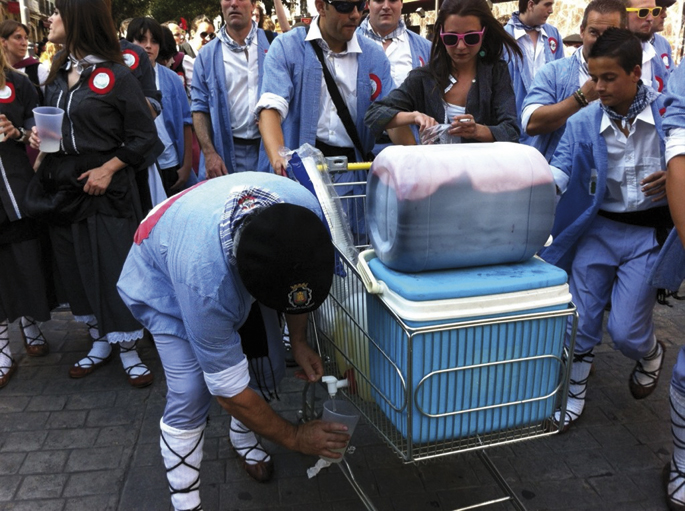
At the festivities of Vitoria-Gasteiz, finally, we cannot forget the Txosnas of Vitoria-Gasteiz that have been collecting representation of popular movements for more than 30 years. In a festive atmosphere, they touch on different areas: the student movement, alternative communication, internationalism, feminist struggle, the defense of the Basque country, the fight against repression… In total, there are 13 collectives and 12 txosnas.
Not all of these associations working for popular festivities in Euskal Herria are alone. Five years ago, the meeting point of the holiday committees of capitals was set up to share experiences and promote joint work. One cannot deny that hard and productive work is being done, “because the popular festivities – says Aitor Alberdi de los Pirates – are an interesting tool to create a different society, and a reflection of this are the aggressions carried out by different authorities against this festive model.” All of this, of course, with laughter, friends and a good atmosphere.
Apart from the party...
Alternative
The Barañain Party Commission has suffered the difficulties of the City Hall to install a txosna, but has been working for years in favor of the popular festivities. This year’s popular programme has been drawn up among dozens of collectives and t-shirts have been put on sale to subsidise the neighbourhood committee’s programme.
Gazte Asanblada prepares the Alternative Parties of Baiona, in collaboration with other groups.
In order to provide an alternative to the stiff holiday program of San Pedro of the City Hall of Lasarte-Oria, citizenship reinforced the Sorgin Dantza a few years ago. Nowadays, the Festival de las Brujas are celebrated in the town, which originated around this dance.
Neighborhood environment
The Auzotarrok movement was born in 2000 of the collaboration of the festival commissions of different neighborhoods of Bilbao. Since then, it has been providing a unified and coordinated response to the needs and problems that may arise in the organization of festivities, sharing infrastructures, permitting a greater cultural offer of quality or promoting popular festivities in neighborhoods.
The Old Town of Vitoria-Gasteiz is the place where the self-managed festivities of pride of the old are celebrated, under the motto Jaiaz and claim Alde Zaharra bizi.
There are many neighborhoods of Euskal Herria that have a great personality or that drive a popular model in their festivities. Examples of this are the festivities of the Errekaleor district (Vitoria-Gasteiz), the Bagatza-Beurkoak (Barakaldo), the self-managed festivities of Moscow (Irun), the Porronos of Egia (Donostia), the Txantrea or Arrosadia of Pamplona, Vitoria-Gastein.
Criticism and parody
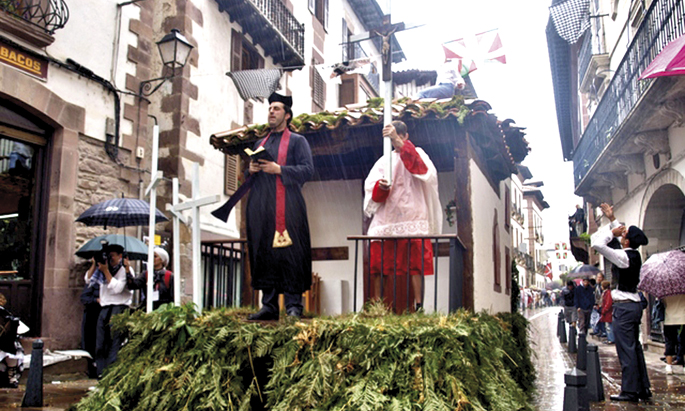
The Baztan Board has suffered many obstacles throughout its history, since its birth in 1963, but it is still alive. At this festival, which intends to be the meeting point of the citizenship of Baztan, they leave in carts, which serve to express the concerns and demands of the neighbors and neighbors of the region. Other cultural activities are also organized throughout the year in the towns of Baztan.
The Labortano Congress, held in Uztaritze, also offers young Labortans the possibility of meeting and bringing their demands to the public plaza through the car route. The festival was created in 1979, when several public holidays were held.
Lasarte-Oria celebrates the parody of the festivities of Santa Ana, a theatrical trial to treat in a humorous and critical way what happened during the year. The jury, composed of Santa Ana, San Joaquín, Basajaun and witnesses, has held its 64 edition.
Popular Olympics
In Hernani, the first edition was held in 1988 with the objective of bringing the young people of the locality closer, promoting the Basque Country and offering another leisure model. He made few editions, but in 2010 the citizenship has regained the initiative and remains strong, with the arrival of the cooperative games.
In Hondarribia, the Olympics were maintained between the late 1980s and 1996. This year they have been resumed to strengthen the connection between the gangs and to get people out of the premises to the street. Given the success of the second edition, it is safe.
Diversity
Six years ago, Lonjero Eguna was born in the Valley of Trapagina, with the objective of getting young people out of their premises and getting to know each other. The initiative has succeeded in increasing the participation of young people in local initiatives, strengthening the social fabric and fostering confusion and diversity of citizenship. It is held in June.
Taking as a starting point the festivities of San Fausto, the comparison Zapaburu of Durango was born with the aim of rejuvenating the streets and removing people from the locals. Events are organised throughout the year.
The association EH 11 Kolore reflects on the diversity of origin and the richness that this diversity brings to Basque society. In the context of this work, he has organized his own festivities (in Donostia or Pamplona, for example) and has participated in numerous festivals, in which he has claimed diversity (such as EHZ or Fiesta of the Basque Public School).
Euskera
The Beterri rock of Tudela works to be “a benchmark in the academic landscape of the Ribera”.
Under the motto Euskaraz besta nahi dut, several party committees of Ipar Euskal Herria are working on ways to promote Euskera at parties, including the measures and the report of the Council of Social Entities of the Basque Country.
Feminism and freedom
Sustraiak Dantza Taldea de Legazpi, who participates in numerous festivals, interconnects boys and girls in the dances according to their desire and need, not according to their role. Even in those that have been considered as dances of boys (Ezpata dantza, for example), girls also act.
During the cider season, the Hernani Feminist Brigade is dedicated to spreading the feminist festival through the streets and claiming spaces “without repugnant, without slugs or maromas”. Similar to the Baiona festivities, where feminist groups from PAF and Altxa Neskatxa organize feminist poteo.
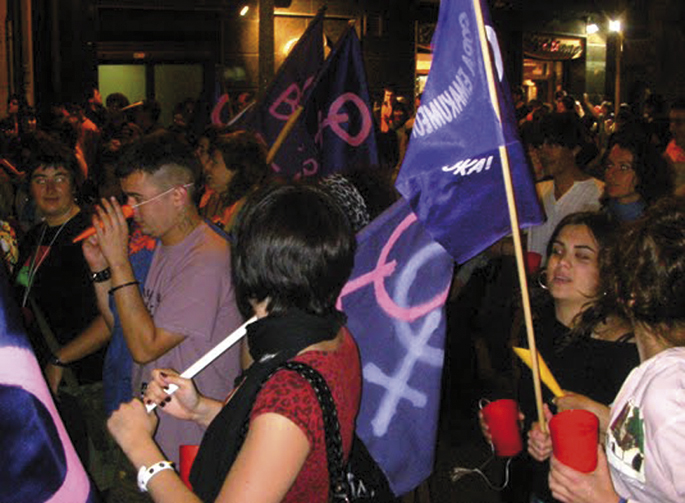
In Zarautz a day is dedicated to working on sexuality, relationships, healthy littoral… and for this, during these years they have carried out a chain of kisses, a lesgaytrans play, a Gona Festa (inviting everyone to approach the txosna with skirt to break gender roles), a colorful demonstration…
Akelarre is an emancipating festival, often also in terms of sexual tendencies, criticism and transgression. It is held in Hernani, Leioa and Barañain, among others, and in Zugarramurdi, Bruja Day.
Environment
In Amikuzen there is the farmhouse Bizi Toki, a pedagogical project that aims to be an alternative to school, and the festivities and celebrations that are usually organized are closely linked to the environment and the land. Proof of this is the Congress of the Witches on Wild Plants, the Semen of Seeds and the Congress of Beekeepers on the knowledge and production of seeds, and the Congress of Beekeepers on Beekeeping.
Claim
The Estella-Lizarra festival commission has promoted an appeal to the popular festivities and has carried out various activities, as UPN has prevented the installation of txosnas in the festivities of the Puy neighborhood.
Under the motto Fiestas in the town of Irun, not in Ficoba, the neighbours have denounced the transfer of the San Marcial holiday enclosure from the centre of Moscow to the Ficoba building. The City Hall has not managed to change its mind, and they have prepared an alternative programme at the holidays of Irun live Moscow! to keep it.
At Erandio they also want to recover the txosnas in Sanagustinas. A few years ago, the City Hall changed its focus to Tartanga and this year, for the umpteenth time, the citizenship has asked it to change its attitude, Txosnas to the center of the town! Campaign. They also propose an alternative space.
Progressive values
On the Jaiak Bultzatuz website, different institutions, associations, people (many known) and about 75 holiday commissions, among which are most of the ones mentioned on these pages, as well as the holiday commissions of the following towns and neighborhoods: Peñas de San Sebastian, Txosnas de Laudio, Comisión de Txosnas de Amurrio, Aramaio, Peña Vieja de Santurtzi, Goiuri, Urbina, Txispak de Zalduondo, Gazte Txispak de Barrundia, Bilbao City Hall.